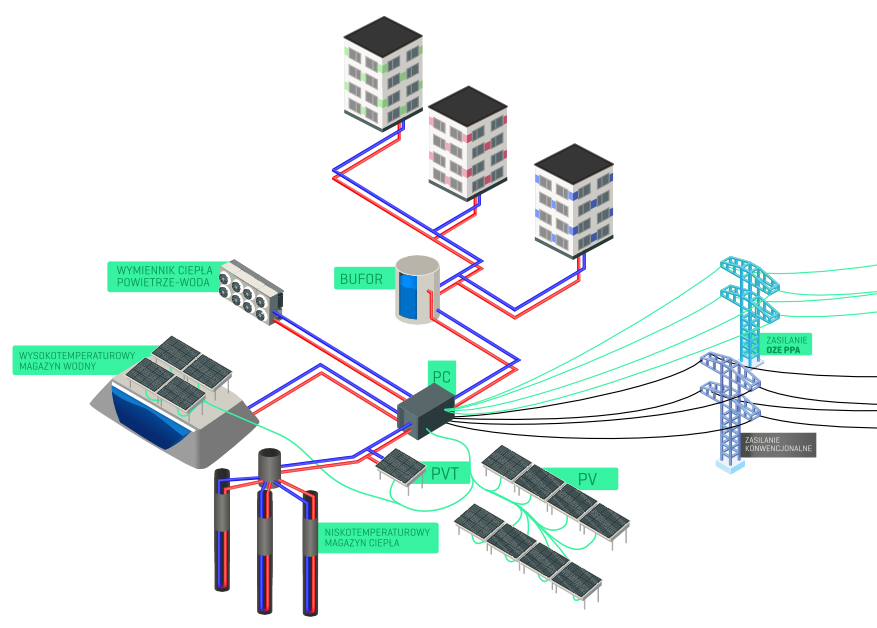The Euros Energy Demonstrator of the Heating Plant of the Future
2G network

Picture credits: The graphics owned by Euros Energy and can be published
Facts at one glance
Status of the project:
Under construction
Operation mode:
Heating network
Geothermal source:
Shallow / Ambient Geothermal
Max heat capacity:
1MW - 5MW
Network generation:
2G
Planned year of operation start:
2023
Contact:
cieplownie@eurosenergy.com
Description of the project
The Demonstrator of the Heating Plant of the Future includes a cascade of heat pumps, PV and PVT installations, as well as two seasonal heat storage facilities – a high-temperature PTES water storage with a capacity of 15,000 m2 and a low-temperature BTES type ground storage with 300 wells of a depth of 99.5 each.
From spring to autumn, heat pumps draw energy from the ambient environment using air heat exchangers and deliver it to seasonal heat storage. In turn, during the heating season, seasonal heat storage acts as the lower heat source for heat pumps. Heat pumps are mainly powered by electricity produced in local PV and PVT installations.
Highlights of the project
Geothermal energy, multiplied by heat pumps, is one of the three available types of heat used by the designed Heating Plant of the Future. The others are the energy stored in the mass of water (PTES type storage) and energy obtained from the air (air-water heat exchanger). Thanks to the integration of a photovoltaic farm with the heat pumps, the heat produced in the system comes in over 90% from RES.
The ground is used as a seasonal heat storage and a lower source for heat pumps. Thanks to the integration of shallow geothermal energy with heat pumps, it is possible to widely use its potential. Seasonal heat storage allows for the accumulation of the available energy in warm seasons for efficient use during heating seasons. In addition to a seasonal heat storage charge, in summer, the system allows for the conversion of energy from ambient air (using an air-to-water heat exchanger) to meet the heating demand of DHW.
The biggest challenges / obstacles
The main obstacle to the implementation of the proposed solution on a large scale is primarily the high investment costs and the required availability of a large area where the system could be constructed. The Euros Energy works on the development and implementation of district heating and combined heat and power systems which might increase the RES share in energy supply in the future.
Detailed characteristic of the project
Site description
Address
Astronomów 47, 11-100 Lidzbark Warmiński, Poland
Status of the project
Under construction
Planned year of operation start
2023
Type of geothermal Heating / Cooling network
Heating network
Type of geothermal technologies involved
Shallow / Ambient Geothermal
Are heat pumps used within this project?
yes - heat pumps to supply the network
Heating network generation
2G
Number of clients supplied
100 - 1000
Depth range
99.5 m
Temperature range
5-20 deg. C
Involved companies
Planner / installer
EurosEnergy Sp. z o.o.
Owner / operator
EurosEnergy Sp. z o.o.
Owner / operator
Veolia Północ Sp. z o.o.
Types of used geothermal sources
Source
Depth range
Temperature range
Purpose
Soil/rock - closed loop
20 - 400 meters
< 20°C
Thermal energy storage
System design
Heat sources included in the network
Multivalent networks - geothermal is combined with more than one other heat source / sink
Max heating capacity supplied by geothermal energy
1MW - 5MW
Share of geothermal energy
60% - 70%
Annual operation hours for heating
2000 hours - 4000 hours
Annual heating production
1 GWh - 5 GWh
Annual heating production share
60% - 70%
Heat source for peak load supply
Electricity
Has backup system?
Yes
Backup system
Fossil fuels
Share of fossil fuels for annual gross heat production
< 10 %